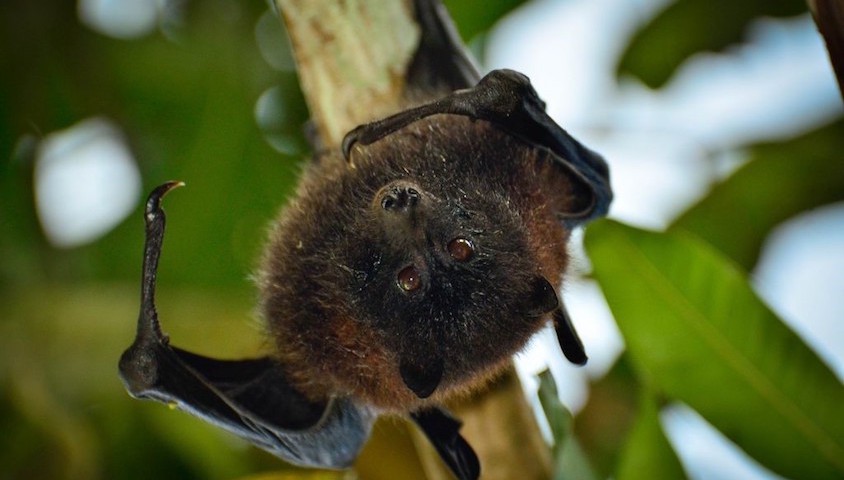Christmas Island, perhaps most famed for its annual red crab migration, is an Australian territory measuring 135 square kilometres, most of which is protected by national park.
The island is also home to a number of unique species that have become threatened by a combination of invasive pests, including cats, black rats and devastating yellow crazy ant supercolonies.
Due to the creation of the Christmas Island National Park in 1980, Parks Australia has taken an active interest in monitoring and working to conserve its native species. Unfortunately, some have seen an irreversible rate of decline in the few decades since such work began.
The Christmas Island pipistrelle (Pipistrellus murrayi), a small insectivorous bat, is one such example. Between 1994 and 2009, researchers witnessed a 90 percent decline in abundance and it is now believed to be extinct.
In a similar vein, Christmas Island’s endemic flying fox species, the black-eared flying fox (Pteropus melanotus), has also seen a significant decline since population surveys began in the 1980s, when the population was estimated to be between 4,000 and 6,000 individuals. Parks Australia has recently announced numbers are now around 2,000 individuals, a modest increase on previous surveys.
Director for National Parks, Sally Barnes highlighted the lessons learned from the loss of the pipistrelle as motivating Parks Australia’s need to quickly develop a management program for the black-eared flying fox, which she believes to be working.
“It was critical we worked quickly to protect this animal, which is the last native mammal on Christmas Island,” Barnes said.
“The knowledge we gained from trying to save the pipistrelle has left us with a great legacy, which has helped us to protect the flying fox.”

Following the extinction of the Christmas Island pipistrelle, the black-eared flying fox is now the island’s only native mammal species. Photo: Yvonne Mckenzie.
Conservation initiatives undertaken by the government department include a feral cat control program, which aims to eliminate all cats from the island by 2020, as well as developing a new method for controlling yellow ant populations; a biological control agent in the form of a micro-wasp that has been shown to target the crazy ants’ food source.
“We also invested $30,000 in designing a flying fox captive management program, so if numbers ever get low again we could trigger this as a conservation mechanism. We‘re not sitting on our hands while our mammals die out and we refuse to give up this fight.”
A key research working with the black-eared flying fox, PhD student Christopher Todd has spent months on Christmas Island developing methods for accurately surveying the species, while also aiming to learn more about its behaviour and ecology.
Speaking with Wild, Todd said that, while “there’s a lot to be positive about” regarding Christmas Island’s flying foxes, their ongoing survival was by no means assured, and ongoing conservation efforts are required if the species should ever hope to have its current ‘critically endangered’ classification removed.
“One of the main problems in studying an animal of this kind is that it’s a relatively cryptic species and this means there’s always a certain margin of error included in any population estimates,” he said.
Researchers traditionally may use direct counts to estimate population size while bats are roosting during the day, but individuals are easily missed when obscured by foliage. Another method, exit counting, relies on counting individuals as they leave their roosts, which also means resulting estimates may be significantly higher or lower than the true figure.
“That’s why we’re trying to improve our sampling methods,” Todd said. “Currently, my work includes a capture, mark, recapture and re-sight methodology which should improve the accuracy for flying fox population estimates.”
But determining the size of the population is just one hurdle to developing a successful management plan for the black-eared flying fox.
“We also don’t know yet which of these potential threats is having the most impact on the bats. Controlling cats and crazy ants is a good thing, but there may also be other issues that need to be addressed.”
Currently working with the Hawkesbury Institute for the Environment, Western Sydney University, Todd has gained experience researching bats around the world for over 10 years, previously working with flying foxes in the Mariana Islands.
“Bats tend to get a bad rap as a flying, nocturnal mammal that sometimes carries disease,” Todd said. “Yet they’re absolutely critical to many ecosystems for their ability to pollinate, disperse seeds or control insect populations, depending on the species.”
“Whether its in forests or agricultural settings, bat species perform many ecosystem services that make them irreplaceable from a conservation perspective.”


